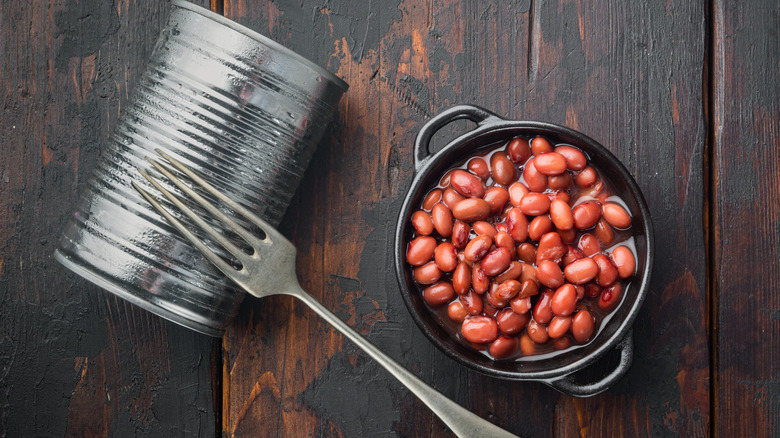Are Canned Beans Raw Or Cooked?
When it comes to stocking a pantry, dry goods like rice, pasta, and flour are usually what come to mind, but no pantry is complete without a few cans of beans. While kidney beans are common, there are at least 10 kinds that are right at home in any kitchen. If you're looking to amp up the protein in a weeknight meal, add a couple of cannellini or butter beans to a brothy soup, or make a quick batch of hummus with some canned chickpeas. All you have to do is open the container and go because canned beans are already soaked and cooked.
Almost all commercially sold canned products undergo a process called pressure canning, which is the safest way to preserve low-acid vegetables and foods, including beans. This process heats the can of food to very high temperatures, which not only kills any foodborne pathogens so that the canned beans are safe to eat, it also cooks the beans. So if you're looking to make weeknight succotash, or a pulled turkey chili, canned beans are your best friend.
Beans are pressure canned
Unless you're an avid homesteader, or you got in on the canning craze that happened during the COVID-19 pandemic, you might not know that there are two ways to can food to preserve it: Water bath and pressure canning. Almost all home canning is of the water bath variety because you don't need a lot of special equipment and you only need to be able to boil water to do it. Water bath canning is only recommended for food that is high in acid, or anything with a pH lower than 4.6, because you only need to boil the canned food to kill any pathogens, and the acid will prevent anything else from growing. This includes things like pickles, jellies, jams, and tomato sauce.
Pressure canning, on the other hand, is required for anything with a pH higher than 4.6, which includes low-acid vegetables, seafood, milk, meat, eggs, and starchy things like beans. This type of canning uses a special pressure cooker to superheat the containers with steam to reach temperatures of 240 to 250 degrees Fahrenheit. This high heat kills any potential lingering pathogens, especially C. botulinum, which causes botulism. For the pressure canning to be successful, the cans have to be held at this high heat for as long as 75 to 90 minutes, which cooks whatever is inside the can, including beans.
To rinse or not to rinse
If you've ever cooked dried beans from scratch you already know that it can take as long as overnight to soak them, and then there's still the matter of cooking. Canned beans have a leg up when it comes to convenience. The one thing you have to look out for with canned beans, however, is added salt. Many varieties of canned beans are packaged with added salt, which gives them more flavor. If you're watching the sodium in your diet, this is one of those sneaky ingredients you need to keep in mind. Most types of beans are canned both with and without added salt, so just be sure to read the label carefully.
If you can't find any beans without added sodium, you can also give them a rinse before you cook with them, which will lower the sodium content. Many recipes call for rinsing your canned beans in general, which will wash away some of the starchy liquid inside the can. However, unless you're trying to cut down on sodium, rinsing is not always necessary. All you have to do to get some bean-y goodness for your next meal is open up a can and dump your beans into whatever you're making — it's that easy!


